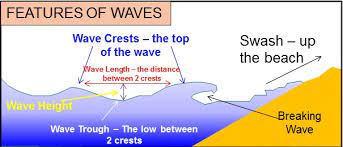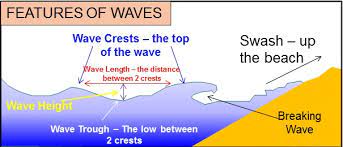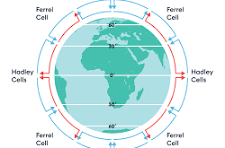Geography paper 1
1/122
Earn XP
Description and Tags
Name | Mastery | Learn | Test | Matching | Spaced |
|---|
No study sessions yet.
123 Terms
1A what is the difference between geological and meteorological hazards?
meteorological- extreme weather events caused by changes in the earth's atmosphere ( cyclones, droughts, floods)
geological- caused by changes to the earths surface (earthquakes, volcanic erruptions, tsunamis)
1A primary effects
Direct impact of the natural hazard
1A secondary effects
indirect effects caused by the primary effects of
1A immediate responses
a response in the days and weeks immediately after a disaster has happened
1A long term response
responses that go on for months and years after a disaster
1A how does vulnerability affect hazard risk?
higher vulnerability means increased hazard risk. for example if a population has poor access to healthcare they are at higher risk of the hazard affecting the population
1A how does economic development affect hazard risk?
if a country has good economic development this means the government has the proper resources to better infrastructure, evacuation centres, emergency services. this reduces hazard risk.
1A how does the nature of natural hazards affect hazard risk?
people who live close to tectonic plate margins are at a higher risk of tectonic hazards and people who live within the tropics are at a higher risk of extreme weather events
1B what is an ecosystem?
natural system that comprises a community of plants and animals that interact with each other and their physical environment
1B what is a producer?
organism or plant that is able to absorb energy from the sun through photosynthesis
1B what is a consumer?
organisms that feed on plants or other animals for energy
1B what is a decomposer?
bacteria and fungi that break down dead plant and animal matter
1B what is an environment?
all conditions that surround any living organisms
1B what is biotic?
living organisms
1B what is abiotic?
non living organisms
1B what are food chains?
a line of linkages between producers and consumers
1B what is a food web?
consists of all the food chains in a single ecosystem
1B what is biodiversity?
measure of how many different species live in an ecosystem
1B what is eutrophication?
occurs when mineral ions from soil are washed away by rain and run into rivers, lakes and ponds
1B what is anoxic water?
water that has no dissolved oxygen
1B explain how human changes could affect ecosystems?
harvesting plants and hunting animals can unbalance the flows and cycles within ecosystems tree-felling may lead to soil erosion and a loss of habitat introducing species unbalances the food chain causing native species not being able to get the right resources
1B explain how physical changes can affect ecosystems?
changes in temperature or water levels can alter the population's of certain species, this can affect the species that depend on them for food extreme weather can disturb the balance of ecosystems
1C features of a wave- destructive
weak swash and strong backwash
strong backwash removes sediment
waves are steep and close together

1C features of a wave- constructive
strong swash and weak backwash
strong swash brings sediment to build the beach
backwash not strong enough to remove sediment
waves are low and far apart

how do waves form?
the wind blows over the sea, friction with the surface of the water causes ripples to form and these develop into waves.
what happens when waves reach the coast?
As a wave nears shore and the depth of water starts to decrease, the frictional effect of the seabed slows the bottom of the wave
what is ‘fetch’?
the distance the wind blows across the water
what is freeze-thaw weathering?
water enters the porous/permeable rock, this water then freezes and expands the crack, ice melts and falls further into the crack, this process is repeated until the rock splits
what is biological weathering?
roots enter a small crack in rock, the roots grow and cause the crack to grow, rock then breaks away
what is chemical weathering?
rainwater which is slightly acidic very slowly dissolves certain types of rocks
what is a rockfall?
fragments of rock break away from the cliff face often due to freeze thaw weathering
what is a landslide?
large blocks of rock slide downhill
what is mudflow?
saturated soil and weak rock flow down a slope
what is rotational slip?
saturated soils slump down a curved surface
what is hydraulic action? (erosion)
power of the waves as they smash against the cliff, air becomes trapped in the cracks and causes the rock to break apart
what is abrasion? (erosion)
pebbles grind along a rock platform, the pebbles then become smooth
what is attrition? (erosion)
rocks that the sea is carrying knock against each other, they break apart to become smaller and smoother
what is solution? (erosion)
sea water dissolves certain types of rocks
what is suspension? (transportation)
particles carried within the water
what is saltation? (transportation)
where small pieces of shingle or large sand grains are bounced along the sea bed
what is traction? (transportation)
pebbles and larger material are rolled along the sea bed
what is solution? (transportation)
minerals in rocks are dissolved in sea water and then carried in solution
what is longshore drift?
where waves approach head on, sediment is simply moved up and down the beach but if waves approach at an angle sediment will be moved along the beach in a zig zag pattern
factors leading to deposition
waves start to slow down and lose energy
shallow water
little or no wind
destructive plate margins
two plates are moving towards each other, the oceanic plate is subducted underneath the continental plate. When the plate sinks into the mantle it melts to form magma. The pressure of the magma builds up , The magma escapes through weaknesses in the rock and rises up through a composite volcano
conservative margins
the plates move past each other causing friction, pressure builds up because the plates are still trying to move. When the pressure is released, it sends out huge amounts of energy, causing an earthquake.
constructive margins
the plates move apart from one another. When this happens the magma from the mantle rises up to make new land in the form of a shield volcano. The movement of the plates over the mantle can cause earthquakes.
what is an epicentre
An epicenter is the point above the focus of an earthquake where seismic waves originate and are most intense
what is the focus of an earthquake?
the place inside Earth's crust where an earthquake originates.
measuring earthquakes- Richter scale
measures the magnitude of an earthquake using a machine called seismometer
measuring earthquakes- moment magnitude scale
this is a more accurate way scientists use to measure the strength of an earthquake
the effects of earthquakes- Chile
February 2010
8.8 on Richter scale
occurred at the destructive plate margin where Nazca moved below south american plate
primary effects: 500 hundred killed, 12000 injured, 220000 homes, 4500 schools destroyed, santiago airport badly damaged, cost of earthquake $30 billion
secondary effect: coastal towns devastated by tsunami waves, fire at a chemical plant near Santiago
the effects of earthquakes- Nepal
April 2015
7.9 Richter scale
destructive plate margin indo-Australian collided with Eurasian plate
primary effects: 9000 died, 20000 injured, 3 million homeless, 7000 schools destroyed, cost of damage $5 billion
secondary effect: landslides and avalanches on mount Everest killed 19
responses to earthquakes- chile
immediate: temporary repairs made to the important route 5 north-south highway, power and water restored to 90% of homes within 10 days, national appeal raised $60 million
long term: chiles government launched a housing reconstruction plan to rebuild 200,000 homes, chiles economy based on copper exports could be rebuilt without much foreign aid
responses to earthquakes- nepal
immediate responses: search and rescue teams arrived quickly from UK and china, field hospitals set up to support overcrowded main hospitals
long term responses: stricter codes on building codes, 7000 schools were rebuilt
why would people choose to live in hazardous areas?
volcanoes can bring benefits such as fertile soils and rocks for building,
cheaper for people living in poverty,
tectonic hazards dont happen very often
reducing the risk of tectonic hazards- monitoring
volcanoes: remote sensing satellites detect heat and changes to volcanoes shape, instruments detect gases released as magma rises
earthquakes: scientists have yet to discover reliable ways to monitor earthquakes
reducing the risk of tectonic hazards- prediction
volcanoes: through scientific monitoring scientists are able to predict and upcoming eruption
earthquakes: its impossible due to lack of clear warning signs, however in historical records scientists are able to identify areas at greater risk
reducing the risk of tectonic hazards- protection
volcanoes: its possible to use earth embankments or explosives to divert lava flows away from property
earthquakes: its possible to construct buildings and bridges to resist the ground shaking, in china buildings have reinforced concrete columns to strengthen buildings
reducing risk of tectonic hazards- planning
volcanoes: hazard maps to identify the areas most at risk can be used to restrict use of certain areas or to plan evacuation of areas
earthquakes: high value land such as hospitals and reservoirs can be protected using maps to show the effects of an earthquake
what is global atmospheric circulation?
the movement of air around the world

how does global atmospheric circulation work?
how does global circulation affect the world’s weather?
describe the distribution of tropical storms?
they are normally found in tropical regions between 5° and 30° north and south of the equator
what is a tropical storm?
storm that develops in the tropics, they form above oceans at 27 degrees plus usually formed in the summer
how do tropical storms form?
strong air draws water vapour up from the ocean surface
evaporated air cools and condenses to form thunderstorm clouds
as the air condenses it releases heat which powers the storm and draws more water from the ocean
once it reaches 75 mph it is a tropical storm
the storm is carried across the ocean by prevailing winds
will climate change affect tropical storms?
distribution: over the last few decades sea surface temps have increased by 0.25 degrees, this will cause the distribution to change
frequency: six of the ten most active years since 1950 have happened since the mid 90’s, frequency may decrease but intensity will increase
how are tropical storms measured?
saffir- Simpson scale, categories ranging from 1-5
typhoon haiyan- primary effects
6300 killed
600000 displaced
30,000 fishing boats destroyed
typhoon haiyan- secondary effects
6 million lost their source of income
power supplies cut off for a month
outbreaks of diseases due to water shortages
typhoon haiyan- immediate responses
international government aid
US aircraft George Washington assisted with search and rescue
1200 evacuation centres set up
typhoon haiyan- long term responses
rebuilding of roads and buildings
‘cash for work’ programmes set up fir people to be paid while helping clear debris
rice farming quickly re-established
reducing effects of tropical storms- monitoring and prediction
in north Atlantic there are two levels of warning issued by the national hurricane centre
hurricane watch- advises that hurricane conditions are possible
hurricane warning- advises that hurricane conditions are expected and that people should take immediate action
reducing the effects of tropical storms- protection
windows, doors and roofs reinforced to strengthen buildings
storm drains constructed in urban areas to prevent flooding
sea walls built to protect properties from storm surges
reducing effects of tropical storms- planning
its mostly about raising individual and community awareness, in USA there is a national hurricane preparedness week which focuses on educating people about potential dangers
what is the difference between weather and climate?
weather is a description of the day to day conditions of the atmosphere, climate is the average weather over a log period of time
what are some of UK’s weather hazards?
thunderstorms- July 2014 dramatic electrical storms following a period of hot weather
prolonged rainfall- during the very wet winter of 2014 flooding was widespread across southern England
drought/extreme heat- rivers and reservoirs can dry up impacting water supplies
why does extreme weather occur in the UK?
it is the meeting point of several different types of weather from different directions
what caused the Somerset levels flood- 2014?
wettest January since records began in 1910, 350 mm of rain fell in January
high tides swept water up the rivers from the Bristol channel
rivers had not been dredged for at least 20 years
what were the impacts of Somerset floods?
social: 600 homes flooded, 16 farms evacuated, power supplies cut off
economic: cost of flood damage more than 10 million, local roads cut off, railway line closed at bridge water
environmental: floodwater heavily contaminated, huge amounts of debris, stagnant water had to be re oxygenated before being pumped back into rivers
managing Somerset floods
immediate: villagers used boats to go shopping, volunteers gave support
long term: 20 million flood action plan had been launched , 8 km of the rivers tone and parratt were dredged, road levels increased
why might extreme weather events be on the increase?
scientists believe its due to global warming
more energy in the atmosphere could lead to more intense storms
atmospheric circulation may be affected
global effects of climate change
glaciers and ice caps are shrinking
arctic sea ice is less extensive affecting polar bears
low lying islands are under threat from sea level rise
what is the evidence for climate change?
scientists use indirect data stored as a fossil record, when layers of sediment become buried they trap and preserve evidence of the global temp at that time, scientists compare this to today’s global temp
natural causes of climate change
changes in the earths orbit
variations in heat output from the sun
volcanic activity
what is the greenhouse effect?
the atmosphere allows most of the heat from the sun to pass straight through it to warm up the earths surface, however when the earth gives off heat in the form of long wave radiation some gases are able to absorb it causing the earth to get warmer
the human impact on the greenhouse effect
global concentration of carbon dioxide has increased by 30% since 1850 from car exhausts and the burning of fossil fuels
methane accounts for 20% of the enhanced greenhouse effect by farm livestock and decaying organic matter in landfill sites
nitrous oxides are released into our atmosphere from agricultural fertilizers and sewage treatment
how can climate change be managed- alternative energy sources
the burning of fossil fuels contributes to 82% of all human produced co2 emissions, to reduce this countries are turning to wind, solar or nuclear power
how can climate change be managed-carbon capture
uses technology to capture co2 before it is released into the atmosphere, in recent advancements people are reusing these co2 emissions and producing diamonds as a form of recycling
how climate change can be managed- planting trees
trees act as carbon sinks removing co2 from the atmosphere through photosynthesis, they also release moisture into the atmosphere which has a cooling effect by producing more clouds, reducing incoming solar radiation
adapting to climate change- managing water supply
in the Himalayas most of the 16000 glaciers are receding rapidly, so they collect water in the winter through a system of diversion canals and it freezes in the spring when it melts it will provide water
adapting to climate change- reducing risk from rising sea levels
in the Maldives construction of sea walls is being constructed around the capital, building houses that are raised on stilts, construction of artificial islands so that people most at risk are able to be relocated
the distribution of biomes (global ecosystems)
tropical rain forest- near the equator, high temperature and heavy rainfall , quarter of all medicines come from these rain forests
desert- 30 degrees north and south of the equator, high daytime temps low night time temps
polar- arctic/antarctic, very low an dry conditions
grassland- 30- 40 degrees north and south of the equator, warm dry summers with cold winters
Mediterranean- 40 degrees north to the equator mild winters with warm summers
tropical grassland- 15- 30 degrees north and south of the equator, wet and dry seasons
tundra- 60 degrees north, windy and dry climate
how have plants adapted to rainforests?
Lianas - these are woody vines that have roots in the ground but climb up the trees to reach the sunlight.
Tree trunks tall and thin to allow trees to reach the sunlight. The bark on these trees is smooth to allow water to flow down to the roots easily.
how have animals adapted to rainforests?
The sloth uses camouflage and moves very slowly to make it difficult for predators to spot.
The spider monkey has long, strong limbs to help it to climb through the rainforest trees.
what are the four layers of a tropical rainforest?
case study- deforestation in Malaysia
logging: Malaysia becomes the worlds largest exporter of tropical wood in the 1980’s, this has led to the total destruction of forest habitats
mineral extraction: its rainforest has been cleared for mining and road construction
commercial farming: largest exporter of palm oil in the world, during the 70’s large areas of land were converted to palm oil plantations, owners receive 10 year tax incentives